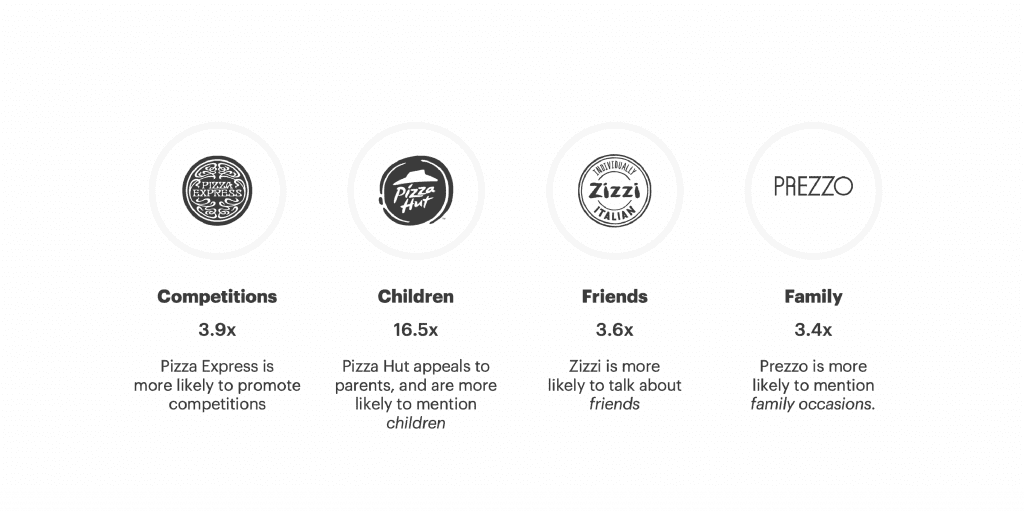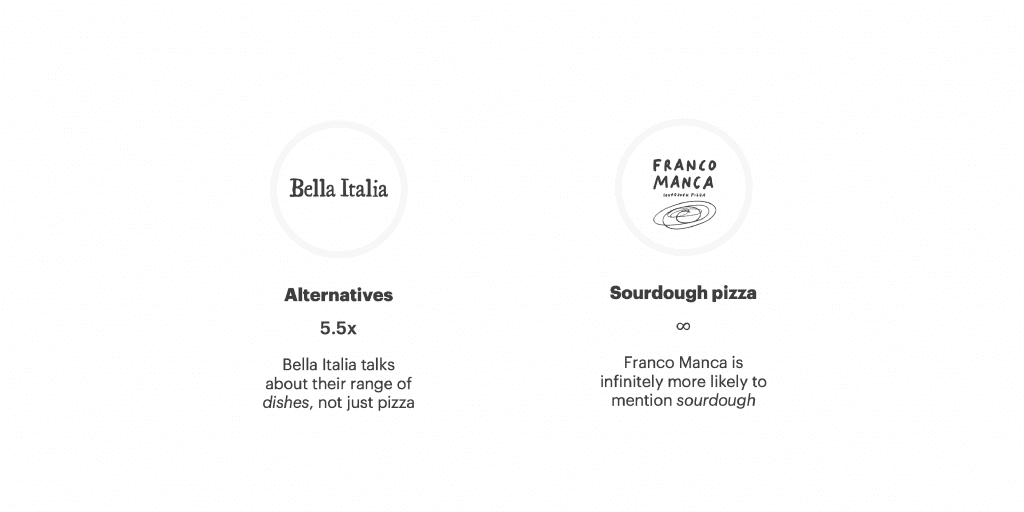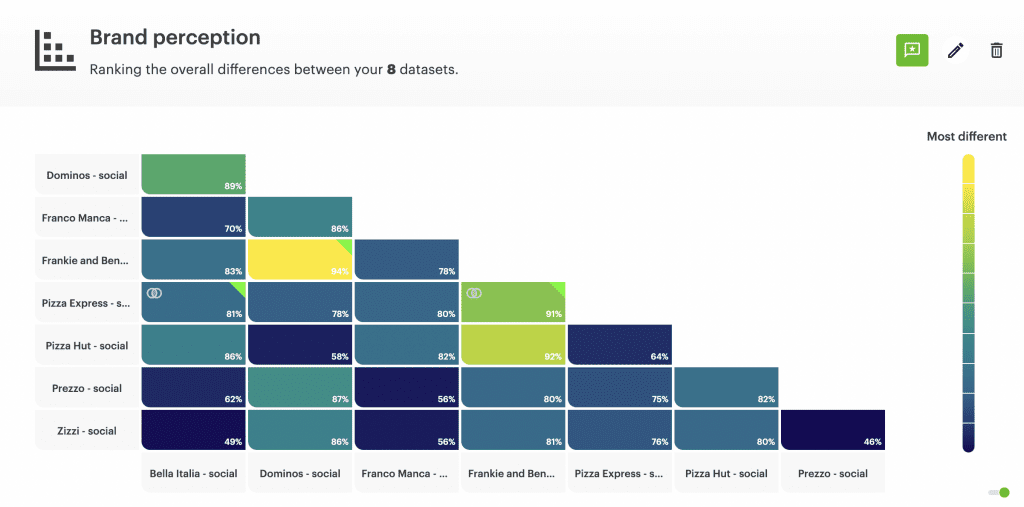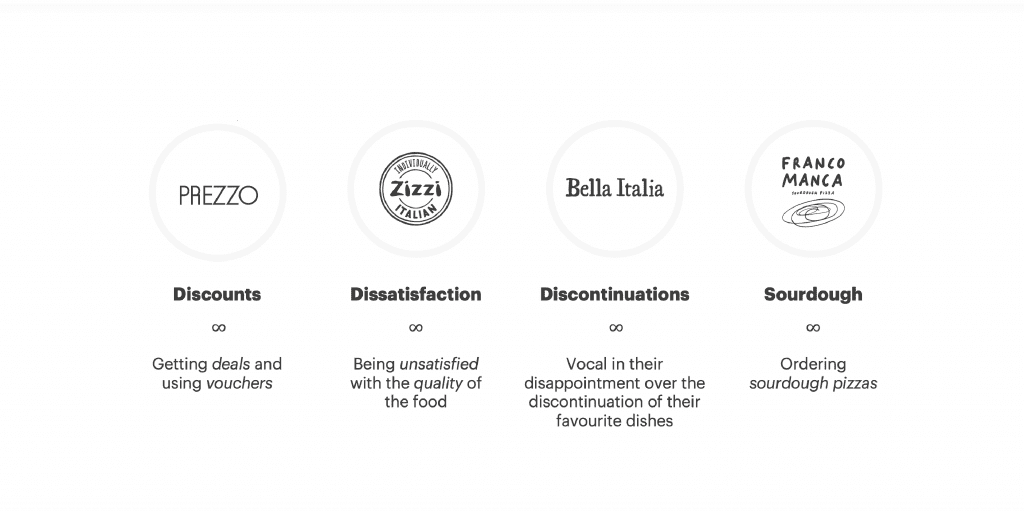Analyzing marketing communications and brand perception of pizza chains

There’s something comforting about chain restaurants – knowing that when you order your favorite dish, you’ll know exactly what’s going to arrive, without fail. Consistency is underrated.
The pizza industry has grown to be one of the largest segments in the food industry, with an estimated worth of £2.1 billion. However, the likes of Pizza Express, Domino’s and all other mid-tier pizzerias are surprisingly similar. These pizza restaurants have the same price points, the same deals, and the same perception of consistency, but in a crowded industry, many chains fail to differentiate their marketing from their competitors. So how does brand perception of popular pizza chains differ?
Food brands are utilizing Relative Insight to understand the competitive environment. Relative Insight is a text analytics platform that pinpoints the linguistic differences between two or more text data sets. Our comparative approach to text analysis offers a unique solution to companies, who want to analyze and compare the brand messaging and brand perception of significant competitors.
For this competitor analysis, we’ve taken a journey into the heart of pizza marketing, investigating how pizza chains position themselves in a busy landscape, and how customers also speak about these brands on social media. These insights helped us assess general brand perception of popular pizza chains.
Brand messaging
Firstly, we pulled the website copy and social media content of Pizza Express, Pizza Hut, Domino’s, Zizzi, Bella Italia, Prezzo, Frankie and Benny’s and Franco Manca, and uploaded these competitor data sets directly to Relative Insight.
We then compared each pizza brand’s marketing and communications against all other competitors in the set, to discover what was unique or similar about them and assess the competitive landscape. The platform reveals an endless number of insights that couldn’t possibly fit in one article, but here’s the most interesting…
Pizza Express
A main difference for Pizza Express was that it uses Twitter to promote competition. The words win and competition is 3.9x more likely to appear in this data set, meaning that other pizza competitors are less likely to use this marketing strategy. This an opportunity that competitors could be utilizing to engage with their consumer base and attract new customers.
Pizza Hut
In contrast, Pizza Hut is 16.5x more likely to talk about children throughout its messaging. It discusses its child-friendly options and emphasizes that its “servers have children’s needs at the front of their minds.” This is appealing to parents with young children as an option for eating out with little fuss.
Prezzo
We found that Prezzo are 3.4x more likely to mention the word family and the phrase family feast. Prezzo positions its brand as a family-orientated restaurant, that acts as the host of celebrations and special occasions such as birthdays and anniversaries. However, whereas Pizza Hut places emphasis on being a children-friendly restaurant, Prezzo talks more holistically about being a place for families (of all ages) to celebrate.
Zizzi
Our analysis also uncovered that Zizzi is 3.6x more likely to use words such as friends and great times throughout its communications. By suggesting going for food with friends, Zizzi makes their restaurant seem like a social hotspot. However, this also provides them with an opportunity to get more customers.


Bella Italia
Our analysis found that Bella Italia is 5.5x more likely to talk about its range of dishes on offer at the restaurant, such as pasta and carbonaro. Clearly, Bella Italia is capitalizing on the fact that its restaurant has variety and choice, which differentiates it from other players who primarily serve pizza.
Franco Manca
Franco Manco is unique in offering sourdough pizza, and it is infinitely more likely to talk about this on its website and social media. Franco Manca often just refers to its pizza as sourdough, and really owns this section of the market in the pizza industry offering authentic, freshly made pizzas to its customers. It also mentions how its pizza kits are available to enjoy at home.


Brand perception of popular pizza chains
Analyzing brand messaging is only half of the story. It’s vital to look at competitor research from customers’ perspectives. Because if you’re not speaking in the same language as your customers, you might be missing the mark.
As an extra layer of analysis, we compared brand mentions of all eight pizza chain competitors on social media. This enabled us to understand how these competitors stack up in the eyes of the consumer and uncover key audience insights.
Using heatmaps
To decide which brands were the most and least different from a consumer point of view, we utilized Relative Insight’s Heatmaps feature. This visualization tool quickly enables us to see which data sets have the most linguistic differences. This type of pre-analysis shows us which comparisons will yield the most interesting insights into the brand perception of popular pizza chains.


We found that the language used by Franco Manca, Prezzo, Zizzi and Bella Italia customers was the least different, which is a key insight in itself. You see, it’s important to explore the linguistics differences of the competitor you’re closest to, as these are usually the brands whose customer base and market share you could easily target.
Franco Manca
What’s interesting is that in tweets that mentioned Franco Manca, customers were infinitely more likely to speak about ordering sourdough pizza and pizza kits. This is an important insight as it shows that Franco Manca’s marketing efforts are being recognized by its customers, who see sourdough and pizza kits as their unique selling points. Clearly, Franco Manca’s brand strategy is aligning with its consumer base.
Prezzo
Prezzo consumers were infinitely more likely to talk about vouchers and rewards they could use at the chain. For instance, being able to use buyagift and Tesco Clubcard vouchers or saving money by going for dinner on a Tuesday or Wednesday with Meerkat Meals.
Zizzi
When compared to its main competitors, customers of Zizzi were dissatisfied with the quality of food, complaining that their pizza was soggy. An important reason that brands are using text analysis solutions such as Relative Insight is to spot consumer trends, particularly negative ones, in order to proactively remedy problems before they evolve. By knowing that Zizzi’s customer have this opinion on pizza, the brand can seek to rectify this issue.
Bella Italia
Our analysis of brand perception of popular pizza chains revealed that Bella Italia customers took to Twitter to express their disappointment and upset that their favorite dish has been taken off the menu – marco polo. This is a key insight that helps Bella Italia understand consumer reactions to changes in their menu, but also shows that competitors should test their strategies before implementing them.


the art of competitor analysis
Competitor analysis is all too often based on numbers. But the reality is, understanding the language your competitors use to market themselves, and the language that customers are using can help you differentiate your brand and reveal opportunities.
Book a demo with one of our text analysis specialists to learn how brands are using Relative Insight to stay ahead of the competition.
